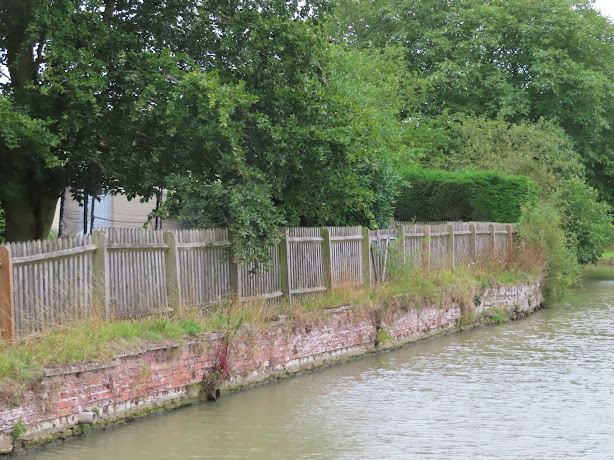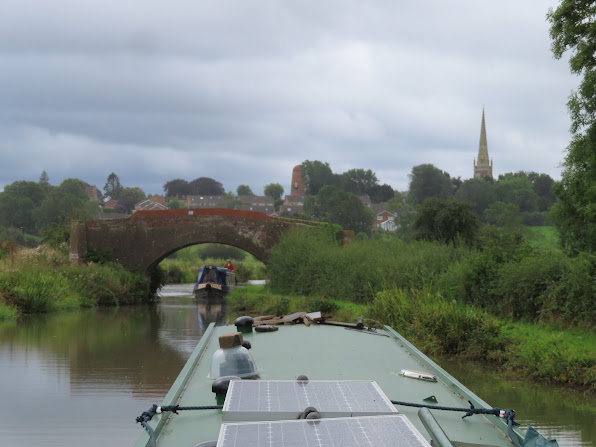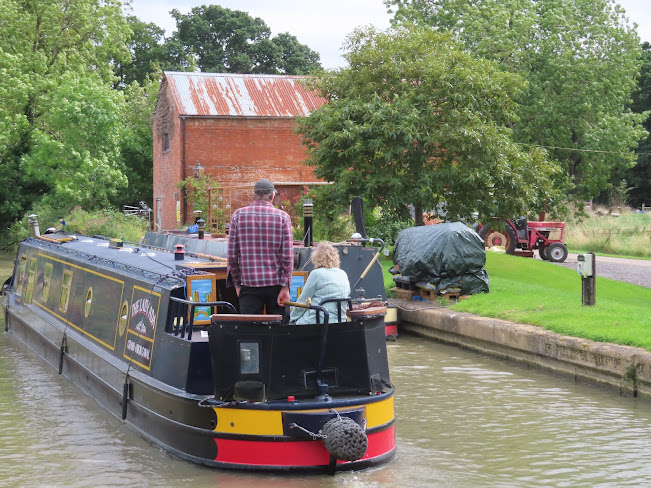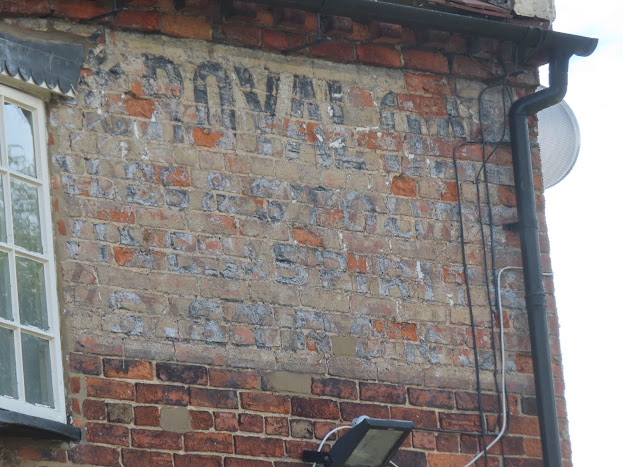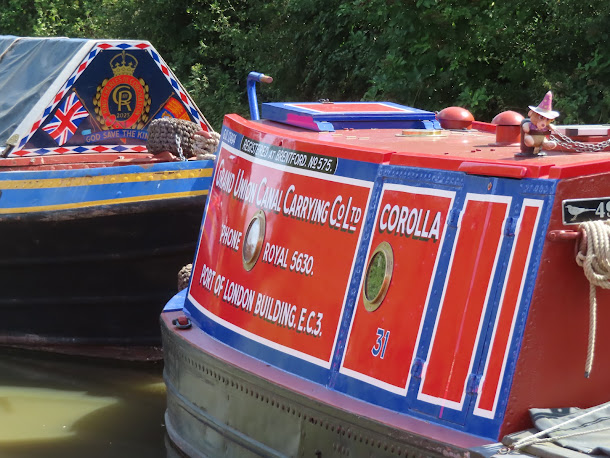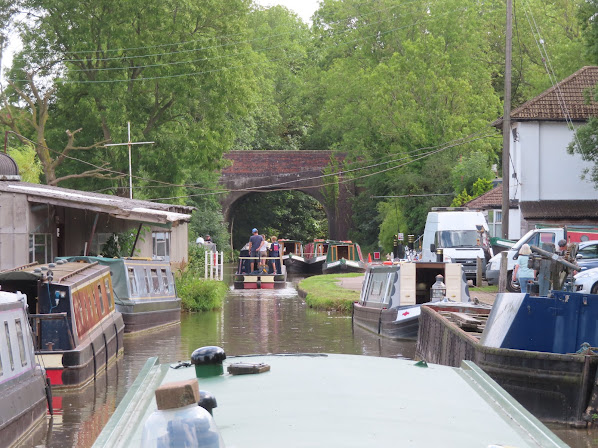Not that it kept me awake at night, but every waking hour there was the sign of barking dogs in the distance. I looked and found a kennels and cattery not too far away. One or two of the dogs there seem to have a problem as they never stopped. There was sun when we got up to make the tea, but it was pretty windy.
All Oaks Wood was quiet and not at its best, plus there are definitely other trees than oaks to be seen. What is that all about!
The building by Bridge 35, just through All Oaks Wood is the Boat Inn Cottage. I wondered how long ago it was a pub. I can see that it went for auction in 1856 but didn't seel. It had a small farm attached then. In 1864, on the death of the owner William Johnson, it went for sale again. It was detailed as having stabling for 12 horses, a barn, a wagon hovel, piggeries and a large garden. There was also a coal wharf. The house had a shop on the ground floor with shop, storeroom, parlour and tap room along with a brew house and four bedrooms upstairs. Johnson was also a boat owner. When the owner in 1899, Joseph Burdett, went bankrupt it was sold again, and the last time I can see it that it was licenced was following the death of the owner Fred. Hales it was sold and the licence lapsed.

It is interesting to note the old legs of the contour canal come thick and fast, and looking in Pearson's Guide helps to pass the time trying to spot where it joined and left the current canal. The old line hugged the 300 ft. contour and was a distance of 36 miles between the Coventry Canal, and Braunston Junction. By the later 1820's civil engineering had come on leaps and bounds and the canal was 'straightened' by Cubitt who made his name through railway work. The end result was the mileage was cut by 14 miles! These Horseley Works bridges are dated 1828.
The new Newbold Tunnel is two boats wide and actually has two towpaths, only one in use now. It is 250 yds long. The old route came out roughly where the canal boat is in the picture but has made a large loop to the right, under the road and under the church. The old tunnel was only about 130 yds long. You can still see one of the portals if you can to find it.
As you approach Rugby you can see why the original canal builders followed the contours as it meant they could avoid this road bridge and a little further the crossing of the River Swift, and later the River Avon. There was not too much chaos at the Tesco moorings nearby the water points, there was even places to stop.
This is the new (to us) bridge that takes a road to the new housing complex that has been built on the site of the old Aerial site of Rugby Radio. It used to be on all the radio dials of old. It was the largest transmitter site in the World for many years. It opened in 1926 and was at its peak in the 1950's. The site was sold off in 2007 and I'm sure the aerials were still standing the last time we came through here.
WE waited for a small cruiser to come down the first lock at Hillmorton with a young volunteer Lockie helping. We were soon at the top with another one to help. It has been a quiet season we were told with less hire boat traffic than usual!
This is just part of the new housing complex. It looks like it will eventually be a 'new town'of sorts as it has new schools etc and is not nearly completed as yet.
I noticed this ghost sign on the Waterside Inn at Hillmorton. As far as I can see it says 'The Royal Oak, ales and stouts, Wines and spirits' but I can't make out the last line. It was the Roal Oak until after WWII when it became the Old Royal Oak until very recently, when it has become a Hungry Horse pub called the Waterside.
The building to the left certainly looks like an old warehouse, and coal was being sold from what is Hillmorton Wharf at 71/2d a cwt in 1791, Seven pence ha'penny a hundredweight to our younger readers. It has dealt in deals and timber, hay, corn, sand and lime over the years. In the 1970's the area buy the boat became a boat building and repair yard and in 1977 the small basin was dug for moorings. It seems to be getting a makeover at the moment.
Just down from Hill Morton is this strange set of buildings now know as Wharf Farm. In Pearson's it sates that the buildings to the left was a former wharf and stables. On the 1886 map it shows the large building to the right was the Fox Inn. It doesn't mention a wharf at all, but may have been one. The buildings to the left do have the look of stables but may have been attached to the pub. By 1899 the pub has become Wharf Farm, which certainly implies there was one.
We moored up just before Bridge 81, which is next to the Dunchurch Pools Marina. As soon as we were moored up and the side hatch open this swan family were poking their heads in and trying to snatch food from our hands.
We had a couple of showers through the day, but only one short one that was a little heavy and drove Helen inside.
I set too to finish using all the off cuts of timber I had to make a shelf unit to go under our ladder at the rear door. It will make the stack of boots etc that get stuffed there that little bit tidier. I then refilled the stern galnd greaser and thought I had earned a sit down. Helen produced a cheeky little rose number, and out came the nuts, raisins and chocolates and a real Saturday afternoon was had!
Having passed through I thought I may as well mention the Rugby League Challenge Cup Final. I was a rugby Union man myself, but Hull Kingston Rovers is our local league team to Hedon where we live. They got pipped by Leigh 16-17 with a golden point.
